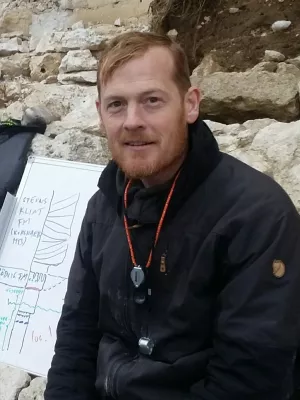Stratigraphy and facies of Middle Silurian epicontinental carbonate platform deposits of Gotland, Sweden
Author
Summary, in English
The Silurian foreland of Scandinavia included a vast epicontinental carbonate platform system of which the island of Gotland (Sweden) is an erosional remnant. This thesis treats the Late Wenlock succession (Cyrtograptus lundgreni, Pristiograptus dubius parvus, Gothograptus nassa, Colonograptus(?) praedeubeli, and the Co(?) deubeli zones), and emphasises the sedimentology and biostratigraphy of these deposits. A new conodont zonation is introduced, encompassing the Kockelella ortus brevis, Ozarkodina bohemica longa and Ctenognathodus murchisoni zones. This interval is characterised by a diverse assemblage of lithofacies, reflecting deposition in a variety of carbonate platform sub-environments; the platform slope to basin transition, the subtidal shoal area, the reef area, and the rocky shore environment. Additionally, a more siliciclastic shelf-like setting evolved when coarser siliciclastics were transported to the basin during regression. These strata are preserved as a detached shoreline along the distal margin of the platform. The bulk of the sediments was deposited when the platform aggraded and prograded during two identified highstand systems tracts (HST). These periods of high sea-level favoured reef growth and skeletal carbonate production. A minor part of the succession accumulated during a forced regressive systems tract and a transgressive systems tract, both identified low in the O. b. longa Zone. Facies of these two stages reflect profound changes to the platform architecture during a 5th order sea-level chage, inferred to be of glacio-eustatic origin. A substantial drop in carbonate production probably preceded the onset of regression and siliciclastic influx. During this regression, storms were the most important process for offshore directed sediment redistribution. As sea-level fell, the shoreline was dislocated many kilometres seaward, resulting in one of the major unconformities in the basin. At the time of maximum lowstand an epikarstic intertidal flat fringed the west-southwest - east-northeast trending shoreline. Reefs did not manage to re-establish during the ensuing transgression ('give-up' scenario). Instead, non-skeletal carbonate shoal facies accumulated along the rocky shores sculpted in strata of the preceding HST. The first reefs re-appeared after a comparably long lag-phase, indicating deterioration of the environment during early transgression. The succeeding aggrading and prograding successions, both on the platform and along its distal slope, indicate that carbonate production phased or exceeded ('keep-up' scenario) the creation of accommodation space through the K. o. brevis and C. murchisoni zones. By utilising sequence stratigraphical concepts, the Late Wenlock sea-level curve is re-evaluated, excluding the long-term regressive trend often quoted in the literature. This reinforces the importance of studying genetic relations of sedimentary bodies, not individual sections, if sea-level curves should have any accuracy. Genetically, the studied interval encompasses two superimposed platforms separated by the epikarst and palaeotopography. The transitional strata are complex due to the depositional bias of the carbonate and siliciclastic depositional systems. Based on the idea that carbonate platforms essentially are major ecosystems, and on the close relationship of the succession and the oceanic Mulde Event, the two platforms are herein further subdivided into five evolutionary stages. Thereby, the relationship between sequence stratigraphy and event stratigraphy has been opened for study. It is shown that at least two of three extinctions among e.g., graptolites and conodonts, were not related to sea-level change. The new data accumulated indicate that the studied succession resulted primarily from regional to global processes. A numerical time-scale, based on graphic correlation, shows in detail the chronology of biotic extinctions and platform disruption, and their subsequent recovery.



